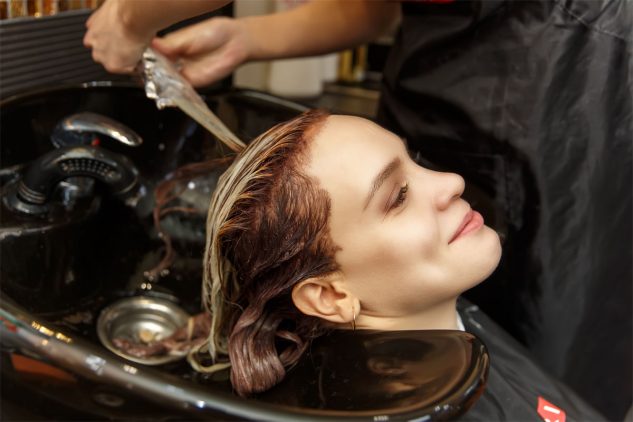Is Dyeing or Coloring Hair Harmful?
Hair dyes are chemicals that individual can utilize to alter the color of their hair. The agents in dyes can damage and weaken hair, in which might make it look unhealthy. Nevertheless, treatments like conditioners and specially created shampoos might help repair hair damage from hair dyes.
Dyeing hair with chemicals or natural dyes can be harmful to hair. This is because the dye might impact proteins and lipids present in the hair, in which contributes to healthy hair. Alterations to the inner and outer structures of the hair’s shaft can harm the hair, making it fragile and inclined to breakage, in which could ultimately result in thinning hair and/ or hair loss in some areas.
Hair dyes can diminish hair strength, but individuals can take precautions to minimize possible damage should they still decide to dye their hair. In addition, other tips are available to help replenish hair and retain its health.
In this post, it discusses the impact of hair dye on hair health and tips for repairing hair damage and maintaining healthy hair.
What Are Hair Dyes, And What Does It Do to Hair?
Hair is comprised of an inner cortex, in which contains a lot of the hair mass, and keratin proteins. The outer layer of hair known as the cuticle surrounds and safeguards the cortex. Hair lipids have an important role in healthy hair and contributes to around two to six percent of the weight of hair. Hair lipids impact the luster and feel of the hair, in addition to hair strength.
Hair dyes are topical substances that alters the color of hair either briefly, semi-permanently, or permanent. Whereas dyeing hair is a common procedure, it can cause damage to the shaft of the hair, making it weak and more apt to breakage.
A lot of permanent hair dyes use a mixture of hydrogen peroxide, ammonia, and p-phenylenediamine (PPD) for coloring the hair. Ammonia opens the protein layers of the hair, in which enables the dye to coat the hair’s shaft. Hydrogen peroxide is going to strip the hair of its natural color, and PPD then binds into the hair for coloring it.
Dyeing hair by any means causes damage to the hair because of:
- altering the structure of the cuticle layer of the hair
- breaking-down proteins in the hair
- decrease of hair lipids
Chemicals to Stay Away From
In a 2020 report, p-phenylenediamine is an allergen that may cause an allergic contact dermatitis reaction. In addition to skin irritation, PPD might also have a link to health issues like congenital abnormalities and blood and liver toxicity.
A 2018 research study discovered that bleaching hair with peroxide results in oxidative damage and loss of protein in the cuticle and cortex of hair.
Products described as “organic” or “natural” might also produce adverse effects. Natural sources, like plants, might still contain allergenic or harmful substances.
The FDA states that since a product is organic or comprises of organic ingredients, it does not mean that it is necessarily safer.
In addition, increasing evidence suggests that some hair dyes may might endocrine-obstructing compounds. These chemicals can mirror the effects of the hormone estrogen and might increase the risk of breast cancer. Research suggests that permanent dyes might contain higher concentrates of aromatic amines, in which might be carcinogenic to people.
Other possible harmful components might include toluene and ammonia. The latter is a respiratory irritant that can cause asthma attacks, and toluene is recognized as a neurotoxin with links to allergic reactions congenital abnormalities, and miscarriage.
Whereas these are common components, hair dye alternatives exist that don’t use harsh chemicals. Individuals may want to examine labels or components lists on hair products to look for chemicals that might be harmful.
Does Hair Color, Hair Kind, or Dye Kind Matter?
The kind of hair dye may impact how much damage to hair occurs. Hair damage can happen in any hair kind, as it impacts the inner and outer composite and make-up of the hair.
Brief dyes only com to the outer layers of the hair shaft and usually wash away with 1 shampoo wash.
Semi-permanent dyes rid natural coloring from the hair shaft, however, are weaker than permanent ones. Meaning they usually cause lesser damage. Semi-permanent dyes usually wash out within four to twelve shampoo washes.
Permanent dyes permeate deeper into the cortex of the hair, bleach the natural color, and trap color bits within the hair’s shaft. That process can cause damage to the hair.
The differences between natural hair color and the color individuals want to dye their hair might also play a part in damaging their hair. The big the variation between natural color and dye colors, the more damage may happen. A 2018 report showed that protein loss grew based on how harsh the bleaching was with peroxide hair dyes.
Natural dyes also can damage hair. A 2019 report that used goat hair instead of human hair, henna dye impaired the hair cuticle.
Repairing Damaged Hair
Hair dye is going to impact hair strands until the color grows-out. To decrease the damage from hair dyes, individuals can decide on a conditioning hair dye type. As reported by a 2018 study, hair dyes including conditioning agents like hydrolyzed silk or milk proteins might decrease the damage from dyeing hair.
Using a shampoo that includes lipids, like fatty alcohols, can also help to restore lipids in the hair and improve strength in the hair.
The AAD suggests the following hair care tips for dyeing the hair and maintaining overall hair health:
- Utilize a specially formulated shampoos for color-treated hair.
- Stay as close to the natural hair color as much as possible, staying inside of three shades of the natural color and darkening instead of lightening where possible.
- Safeguard the hair from the sun by wearing a hat in sunny conditions.
- When perming the hair, adhere to product instructions carefully to avoid any extended damage.
- When using a relaxer, consult a stylist to guarantee safe application.
- When having multiple treatments, like coloring, relaxing, or perming, try to space out the time between sessions.
- Use conditioner following every hair wash, specifically on the ends of the hair.
- Decrease heat on the hair, like from styling tongs, and use a heat-protective product beforehand.
- Decide on hair products that match hair type.
- Safeguard hair from chlorinated water by wearing a form-fitting cap when going for a swim.
- Perform a patch tests of hair dye prior to applying it all over to check for any irritability.
Allergic Response
To ascertain an allergic reaction to a hair dye, individuals can first carry out a patch test. Some hair dye products might have different instructions for a patch test that individuals can follow.
Patch tests usually involves the application of a small amount of hair dye on the inner side elbow or behind the ear, with coverage of an area of about 1 sq cm. individuals can then let the dye dry and look after the area for any indications of irritation. It might help to wait a few days following the test, as a reaction might not happen immediately. When there are no indications of irritation, individuals can then apply the dye to the area of hair they are wanting to color.
Certain ingredients in hair dye, like PPD, might cause an allergic reaction. The below can be indications of an allergic reaction:
- a burning feeling
- irritation
- itching
- skin discoloration
- sores
- swelling
Allergic reactions might happen as soon as using a product or a couple of days later. When individuals have any swelling of the neck or face or any difficulty breathing, it might be an indication of a serious allergic reaction, and they must seek medical help immediately.
In Conclusion
All kinds of hair dye change the color of hair. Many, specifically ones that are permanent alter the structure and makeup of the hair. A lot of hair dyes can damage both the outer and inner areas of the hair’s shaft. Each of the two, natural and man-made dyes might impair hair, however, permanent dyes could cause more damage as they permeate deeper into the hair shaft.
To decrease damage from hair dye or help restore hair, individuals can decide on hair dyes that include conditioners. In addition, utilizing shampoos containing proteins and lipids might help amend damage. Individuals can follow common hair care tips, like avoiding heat, tension, and other chemicals to retain hair health.
Source:
-
MediLexicon International. (n.d.). Does dying hair damage it, and is it repairable? Medical News Today. Retrieved October 6, 2022, from https://www.medicalnewstoday.com/articles/does-dye-damage-hair#allergic-reaction
Hair By Nassi Offers Balayage Hair Highlights In Mesa & Scottsdale
Looking for Balayage Hightlight in Mesa or Scottsdale? Hair by Nassi can help! Contact us today for a free consultation.

